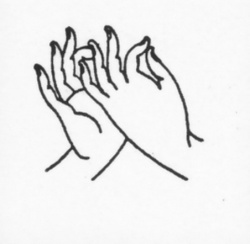Difference between revisions of "Dharmachakra (Wheel-Turning) Mudra"
| Line 1: | Line 1: | ||
[[File:DharmachakraMudra.JPG|thumb|250px|]] | [[File:DharmachakraMudra.JPG|thumb|250px|]] | ||
| − | Dharmachakra in Sanskrit means 'Wheel of Dharma'. This mudra symbolizes one of the most important moments in the life of [[Buddha]], the occasion when he preached to his companions the first sermon after his Enlightenment in the [[Deer Park]] at [[Sarnath]]. This event is often referred to as the setting into motion of the Wheel of the teaching of the | + | [[Dharmachakra]] in [[Sanskrit]] means '[[Wheel of Dharma]]'. This [[mudra]] [[symbolizes]] one of the most important moments in the [[life]] of [[Buddha]], the occasion when he [[preached]] to his companions the first {{Wiki|sermon}} after his [[Enlightenment]] in the [[Deer Park]] at [[Sarnath]]. This event is often referred to as the [[setting into motion of the Wheel of the teaching of the Dharma]]. |
| − | In this mudra the thumb and index finger of both hands touch at their tips to form a circle. This circle represents the Wheel of Dharma, or in metaphysical terms, the union of method and wisdom. | + | In this [[mudra]] the thumb and index finger of both hands {{Wiki|touch}} at their tips to [[form]] a circle. This circle represents the [[Wheel of Dharma]], or in [[metaphysical]] terms, the [[union of method and wisdom]]. |
| − | The three remaining fingers of the two hands remain extended. These fingers are themselves rich in symbolic significance: | + | The three remaining fingers of the two hands remain extended. These fingers are themselves rich in [[symbolic]] significance: |
| − | The three extended fingers of the right hand represent the three vehicles of the Buddha's teachings, namely: | + | The three extended fingers of the right hand represent the [[three vehicles]] of the [[Buddha's teachings]], namely: |
| − | * The middle finger represents the 'hearers' of the teachings | + | * The middle finger represents the '[[hearers]]' of the teachings |
| − | * The ring finger represents the 'solitary realizers' | + | * The ring finger represents the '[[solitary realizers]]' |
| − | * The Little finger represents the [[Mahayana]] or 'Great | + | * The Little finger represents the [[Mahayana]] or '[[Great Vehicl]]e'. |
| − | The three extended fingers of the left hand symbolize the [[Three Jewels]] of Buddhism, namely, the Buddha, the Dharma, and the Sangha. | + | The three extended fingers of the left hand [[symbolize]] the [[Three Jewels]] of [[Buddhism]], namely, the [[Buddha]], the [[Dharma]], and the [[Sangha]]. |
| − | Significantly, in this mudra, the hands are held in front of the heart, symbolizing that these teachings are straight from the Buddha's heart. | + | Significantly, in this [[mudra]], the hands are held in front of the [[heart]], [[symbolizing]] that these teachings are straight from the [[Buddha's]] [[heart]]. |
| − | This mudra is displayed by the first Dhyani Buddha Vairochana. Each of the [[Five Dhyani Buddhas]] is associated with a specific human delusion, and it is believed that they help mortal beings in overcoming them. Thus, [[Vairochana]] is believed to transform the delusion of ignorance into the wisdom of reality. By displaying the [[Dharmachakra]] [[mudra]], he thus helps adepts in bringing about this transition. | + | This [[mudra]] is displayed by the first [[Dhyani Buddha]] [[Vairochana]]. Each of the [[Five Dhyani Buddhas]] is associated with a specific [[human]] [[delusion]], and it is believed that they help {{Wiki|mortal}} [[beings]] in [[overcoming]] them. Thus, [[Vairochana]] is believed to [[transform]] the [[delusion]] of [[ignorance]] into the [[wisdom]] of [[reality]]. By displaying the [[Dharmachakra]] [[mudra]], he thus helps {{Wiki|adepts}} in bringing about this transition. |
{{R}} | {{R}} | ||
Revision as of 05:18, 23 March 2014
Dharmachakra in Sanskrit means 'Wheel of Dharma'. This mudra symbolizes one of the most important moments in the life of Buddha, the occasion when he preached to his companions the first sermon after his Enlightenment in the Deer Park at Sarnath. This event is often referred to as the setting into motion of the Wheel of the teaching of the Dharma.
In this mudra the thumb and index finger of both hands touch at their tips to form a circle. This circle represents the Wheel of Dharma, or in metaphysical terms, the union of method and wisdom.
The three remaining fingers of the two hands remain extended. These fingers are themselves rich in symbolic significance:
The three extended fingers of the right hand represent the three vehicles of the Buddha's teachings, namely:
- The middle finger represents the 'hearers' of the teachings
- The ring finger represents the 'solitary realizers'
- The Little finger represents the Mahayana or 'Great Vehicle'.
The three extended fingers of the left hand symbolize the Three Jewels of Buddhism, namely, the Buddha, the Dharma, and the Sangha.
Significantly, in this mudra, the hands are held in front of the heart, symbolizing that these teachings are straight from the Buddha's heart.
This mudra is displayed by the first Dhyani Buddha Vairochana. Each of the Five Dhyani Buddhas is associated with a specific human delusion, and it is believed that they help mortal beings in overcoming them. Thus, Vairochana is believed to transform the delusion of ignorance into the wisdom of reality. By displaying the Dharmachakra mudra, he thus helps adepts in bringing about this transition.
